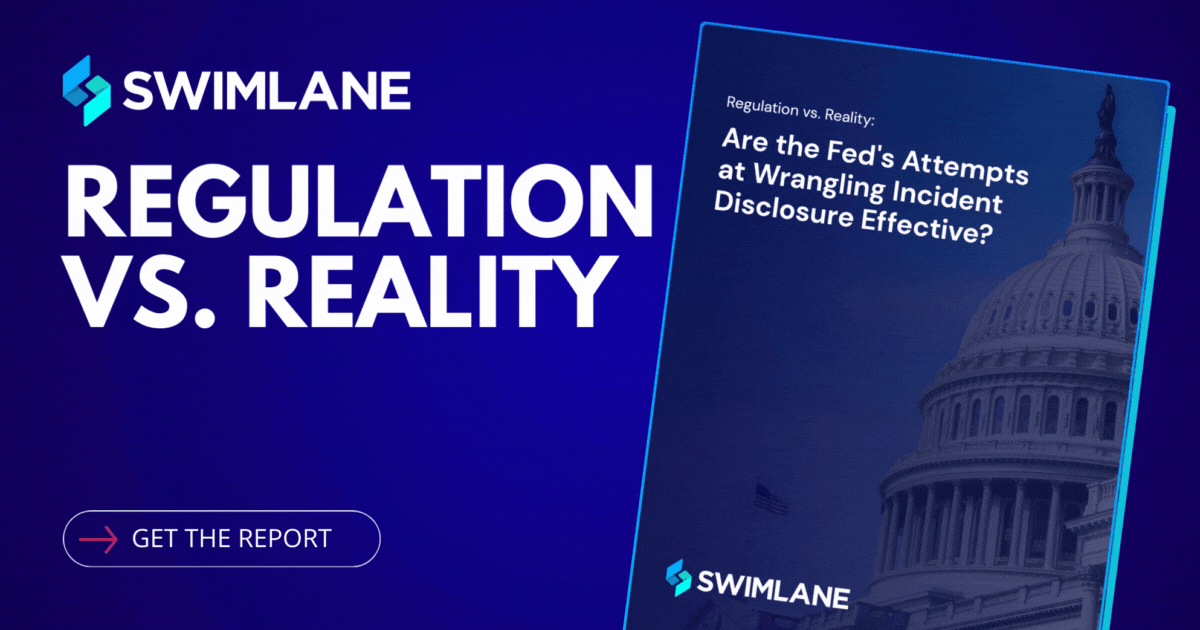From One CISO to Another: Your Guide to Navigate the Complexities of Cybersecurity Materiality
In the ever-evolving landscape of cybersecurity, understanding materiality—the significance of risks and their potential financial impact on an organization—is paramount. Materiality in cybersecurity incidents is crucial because it involves significant financial implications for a company. Legal fees, regulatory fines, remediation costs, and customer notifications all contribute to the materiality of an incident.
As we, as CISOs, grapple with increasingly sophisticated threats, our role becomes indispensable. In a recent podcast interview, I delved into the challenges organizations encounter regarding materiality and SEC compliance. I provided valuable insights into how we at Swimlane effectively address these challenges and manage cybersecurity incident reporting.
Keep reading to learn 13 key takeaways from our conversation and watch the full video here:
13 Key Takeaways for SEC Compliance
- Understand Materiality in Cybersecurity Incidents
As CISOs, we understand that materiality in cybersecurity is about gauging the impact of incidents on our organization’s financial health, operations, and reputation. We need to assess costs, operational disruptions, and potential brand damage to ensure significant incidents are reported to regulators and stakeholders. This approach is essential for effective risk management and maintaining compliance.
- Set Baselines for Controls
Combine regulations like CMMC, NIST 800-53, and ISO 27001. At Swimlane, we built a comprehensive set of controls, mapping these controls to a single system of record, encompassing all assets, including humans, devices, and cloud resources.
- Bridge the Gap Between Control and Risk Discussions
Quantify risk by mapping asset values to sensitivity levels and multiplying them by the likelihood of anomalies. We assess the potential impact, involving the finance team to understand the bottom-line implications.
- The Role of CFO and Risk Discussions
Engaging the CFO in risk discussions involves translating technical risks into financial terms. We use probabilities, impacts, and tabletop exercises to quantify risks, ensuring clear roles and responsibilities across the entire executive team.
- Quantifying Risks in Dollar Terms
While there’s no precise formula, we use a combination of probabilities, impacts, and customer data to estimate risks. Integrating data from our CRM allows us to assess potential exposures accurately.
- Defining Materiality Thresholds
Determining materiality thresholds varies for each organization. While financial considerations are essential, factors like reputation and trust also play a significant role. Transparency and clear communication with stakeholders are crucial.
- The Complexity of Materiality
Materiality thresholds vary significantly between organizations. While some may base it solely on financial impact, others consider factors like reputation and stakeholder trust. The challenge lies in aligning diverse perspectives within the organization on what constitutes a material cybersecurity incident.
- Legal and Regulatory Considerations
The recent implementation of new cybersecurity incident disclosure rules poses challenges for organizations. Even with established frameworks, many struggle to comply fully. The example of organizations like United Health highlights the complexities of meeting regulatory requirements.
- Financial Impact vs. Investor Perception
Determining materiality isn’t just about financial losses but also about how incidents affect investor perception and stock prices. Transparency in reporting is crucial, as failure to disclose non-material events can lead to legal repercussions and worsen public perception.
- Customized Risk Assessment
It’s essential to have a customized approach to risk assessment. While frameworks like NIST 830 offer guidelines, each organization must tailor their methodology to assess the frequency and impact of potential incidents accurately.
- Hybrid Approach to Materiality
The concept of materiality in cybersecurity incidents may require a hybrid approach, considering both quantitative and qualitative factors. While financial losses are essential, other considerations, such as reputation and stakeholder trust, also influence materiality determinations.
- The Role of Automation in Incident Response
Leverage automation and playbooks to streamline incident response processes. This allows for faster and more informed decision-making, enabling organizations to respond effectively to cybersecurity incidents and mitigate risks promptly. As I said on the podcast…
“At Swimlane materiality is easier for us because we drink our own champagne. We have numerous automation incident response playbooks that take care of the brunt of the work so we can make an educated and informed decision and bring that to the leadership team.”
- Continuous Improvement Through Discussion
Continuous improvement in incident response requires open discussions and collaborative efforts across departments. Regular tabletop exercises and war games help raise awareness and foster a culture of proactive risk management within the organization.
Closing Thoughts: Manage Incident Reporting and Meet SEC Compliance with AI-enhanced Security Automation
Now that you’ve absorbed key insights, strategies, and best practices on cybersecurity materiality from my perspective, it’s time to take actionable steps to safeguard your digital assets and mitigate risks effectively. Remember, the pursuit of cybersecurity materiality isn’t just about implementing defensive measures; it’s about fostering a culture of vigilance and adaptability across your entire organization.
As your organization navigates the complexities of cybersecurity incident reporting, let my insights serve as compass points, guiding you towards resilience and proactive risk management. The approach is straightforward: integrate legal, financial, and regulatory considerations. By fostering transparency, engaging stakeholders, and leveraging an AI-enhanced security automation platform like Swimlane Turbine, you will enhance your incident response capabilities and mitigate risks effectively in today’s threat landscape.

Are the Fed’s Attempts at Wrangling Incident Disclosure Effective?
Download the full research report now to understand how these regulatory shifts are impacting security practices and compliance strategies. Read the report to learn more about how the regulatory environment is impacting cybersecurity strategies, priorities, and budgets.


